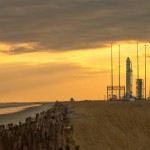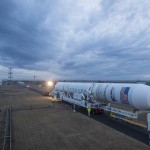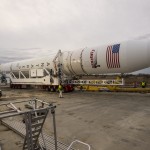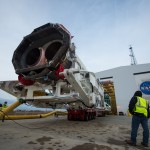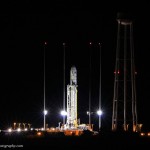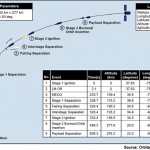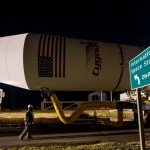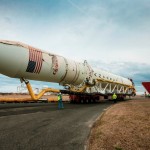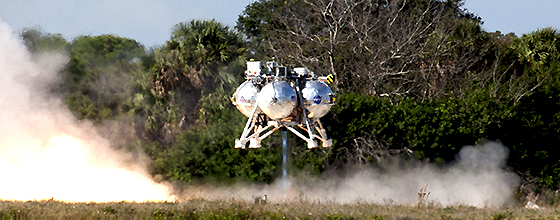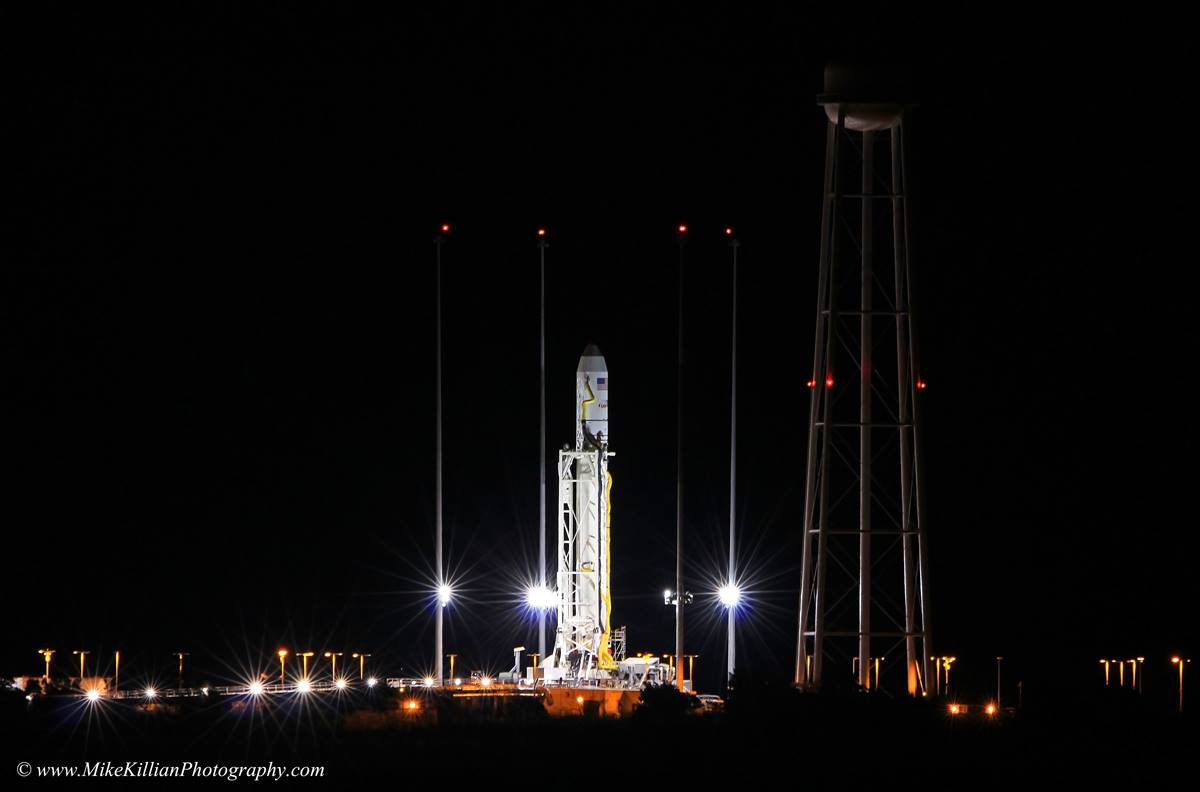
1/8/14 7:00 am EST UPDATE: Early this morning the Antares launch team decided to scrub today’s launch attempt due to an unusually high level of space radiation that exceeded by a considerable margin the constraints imposed on the mission to ensure the rocket’s electronic systems are not impacted by a harsh radiation environment. The solar flux activity that occurred late yesterday afternoon has had the result of increasing the level of radiation beyond what the Antares engineering team was monitoring earlier in the day.
Overnight, Orbital engineers who are experts in the field ran numerous models to ensure that all possibilities to preserve the launch were examined. However, due to significantly elevated flux levels, the Antares team decided to postpone the launch to spend the day further examining the potential effects of the space radiation on the rocket’s avionics suite.
Today, in consultation with NASA and outside experts in the field of “space weather,” Orbital will continue to monitor the levels of space radiation with a goal of setting a new launch date as soon as possible. If we are able to launch on Thursday, the launch targeted launch time would be 1:10 p.m. (EST), with Cygnus arriving at the ISS Sunday morning, January 12.
At Mission Control in Houston, the flight control team reported that the ISS crew is not affected by this solar event and does not require any special precautionary measures.
The Orbital-1 cargo supply mission to the International Space Station received the “go” for launch during a Launch Readiness Review held monday by mission managers from Orbital Sciences Corporation and NASA. At the conclusion of the meeting, they determined that Orbital’s Antares rocket is ready to launch the Orbital-1 cargo supply mission to the International Space Station on January 8. Orbital is targeting a 1:32 p.m. EST launch from Mid-Atlantic Regional Spaceport Pad-0A at NASA’s Wallops Flight Facility in eastern Virginia.
After launch, the Antares medium-class rocket will boost the Cygnus spacecraft into a targeted orbit of approximately 130 x 185 miles (210 x 298 kilometers) above the Earth, inclined at 51.6 degrees to the equator. Following in-orbit activation and testing after launch, Cygnus is slated to rendezvous and berth with the Space Station in the early morning hours on Sunday, January 12.
Antares will lift off the launch pad 2.1 seconds after ignition of the first stage AJ-26 engine. Powered by liquid oixygen and kerosene, the first stage will burn for almost four minutes before shutting down at T+233 seconds at an altitude of 104 km. The solid fuel second stage will separate six seconds later and begin a 107 second coast phase.
The protective payload fairing separates at T+337 seconds, followed by the interstage adapter ring 5 seconds later at 342 seconds into the mission. The second stage ignites four seconds later at an altitude of 180 km.
The upper stage will burn for two minutes, eight seconds to place the spacecraft into orbit 216 km high. Cygnus will separate from the upper stage at T+9 minutes, 54 seconds.
At this point, Cygnus will begin its journey to ISS. After reaching preliminary orbit, Cygnus will deploy its solar arrays and begin a carefully choreographed 4-day series of engine firings to reach the station.
On the day of approach to the station, Cygnus will perform an engine burn that will bring it to a Joint Target Reference Point (JTRP or “Jay-trip”) at 4 km (2.5 miles) below the station. Once achieving the JTRP, a go/no-go poll is performed by the Mission Control Houston team to allow Cygnus to perform a set of thruster firings (burns), ADV 1 and 2, that will bring it to within 1.5 km (0.9 miles) of the station. A second go/no-go will take place from Mission Control Houston after the completion of ADV-2, and then Cygnus will perform another series of burns referred to as “approach initiation” to move from 1.5 km (0.9 miles) below to a position of 250 m (820 ft.) directly below the ISS.
After a “go” from MCC Houston, the Cygnus flight control team in Dulles, Virginia will then command the spacecraft to approach the station from its hold position. It will move from 250 m (820 ft.) below the station to a position 30 m (98 ft.) from the station and will automatically hold at that point.
After another go/no-go poll of the NASA and Orbital flight control teams is completed, Cygnus will proceed to the 12 m (36 ft.) hold position, which is the capture point. A final go/no-go is performed, and the Mission Control Houston team will notify the ISS crew they are “go” to capture Cygnus. At that point, Expedition 37 crew member Mike Hopkins will use the station’s robotic arm, which measures 17.6 m (57.7 ft.) long, to reach out and grapple the Cygnus spacecraft, and with the help of fellow crew member Koichi Wakata, guide Cygnus to the bottom, Earth-facing side of the Harmony node, where it will be attached to the station. If the rendezvous and Cygnus testing runs long, Mission Control could elect to leave Cygnus grappled to the station’s arm overnight before berthing it the next day.
There is a 95 percent chance of favorable weather at the time of launch. High, thick clouds are the primary concern for a weather violation. If needed, multiple back-up launch opportunities are available through Jan. 12.
“Orbital conducted a very successful demonstration mission of the Antares/Cygnus system last September, proving that the company can reliably carry out regularly scheduled operational missions to the ISS for NASA,” said Mr. David W. Thompson, Orbital’s Chairman and Chief Executive Officer. “Now our team is focused on executing another flawless launch and in-orbit operation to deliver much-needed supplies to the astronaut crew on board the Space Station.”
Under a $1.9 billion Commercial Resupply Services (CRS) contract with NASA, Orbital will use Antares and Cygnus to deliver up to 44,000 pounds (20,000 kilograms) of cargo to the ISS over eight missions through late 2016. For these missions, NASA will manifest a variety of essential items based on ISS program needs, including food, clothing, crew supplies, spare parts and equipment, and scientific experiments.
For the first CRS mission, the Cygnus spacecraft is carrying 2,780 pounds (1,260 kilograms) of supplies to the Space Station, including science experiments to expand the research capability of the Expedition 38 crew members aboard the orbiting laboratory, along with crew provisions, spare parts and experiment hardware.
Also aboard the flight are 23 student experiments that will involve more than 8,600 elementary, junior high and high school students from the United States and Canada. These experiments address life sciences topics ranging from vaccine effectiveness and amoeba reproduction to calcium loss in bones and liquid behavior in space. This mission, together with future Cygnus flights, will ensure a robust national capability to deliver critical research equipment and samples to orbit, significantly increasing NASA’s ability to conduct new scientific investigations in the only laboratory in microgravity.
Article by Matthew Travis
Orb-1 Mission Overview
Antares OSP-3 User Guide
Antares Brochure
Antares Fact Sheet
Cygnus Fact Sheet
.
.
.
.
.
